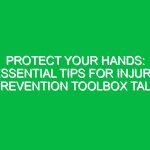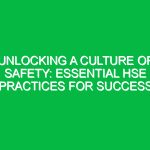In the ever-evolving landscape of construction, safety and comfort are paramount. One crucial element that plays a vital role in ensuring both is construction wear. When we refer to “construction wear near me”, we are highlighting the specific clothing and protective gear that workers need to stay safe on-site. This article delves into the significance of construction wear within the Health, Safety, and Environment (HSE) domain, exploring its relevance, regulations, and practical applications.
Understanding Construction Wear
Construction wear encompasses a broad range of clothing and personal protective equipment (PPE) designed to safeguard workers from potential hazards associated with construction sites. This includes hard hats, safety vests, gloves, boots, and specialized clothing that meets safety standards. The right construction wear not only protects against physical injuries but also enhances comfort, allowing workers to perform their jobs effectively.
The Importance of Construction Wear in HSE
In the context of HSE, the importance of construction wear cannot be overstated. Here are some key points to consider:
- Protective Features: Construction wear is designed to protect against various hazards, including falling objects, electrical risks, and sharp tools. For instance, hard hats prevent head injuries, while steel-toed boots protect feet from heavy equipment.
- Visibility: High-visibility clothing is crucial, especially in low-light conditions. Safety vests with reflective strips ensure that workers are seen by machinery operators and other personnel on site.
- Weather Resistance: Construction workers often face extreme weather conditions. Wear designed for insulation or ventilation can ensure comfort and focus, reducing the risk of heat stress or hypothermia.
- Compliance with Regulations: Many regions have specific regulations governing construction wear. Compliance not only protects workers but also shields employers from legal consequences.
Components of Construction Wear
The components of construction wear are diverse and tailored to meet the unique needs of different job roles within the construction sector. Let’s explore the essential items:
1. Hard Hats
Hard hats are a staple of construction wear, designed to protect the head from falling objects or collisions. They come in various types, including those with additional features such as earmuffs or face shields for added protection. Regular inspections and replacements are necessary to ensure their effectiveness.
2. Safety Vests
Safety vests, often fluorescent with reflective tape, enhance visibility, particularly in environments with moving vehicles. They are essential for workers on sites with heavy machinery. The American National Standards Institute (ANSI) sets the standards for these vests, ensuring they meet safety requirements.
3. Gloves
Construction gloves provide grip and protect hands from cuts, abrasions, and chemical exposure. Different tasks require different types of gloves, such as cut-resistant gloves for masonry work or rubber gloves for handling hazardous materials.
4. Steel-Toed Boots
Steel-toed boots are designed to protect the feet from heavy objects and provide slip resistance. They are a critical component of construction wear, and selecting the right fit is crucial for comfort and safety.
5. Respirators and Face Masks
In certain environments, especially during demolition or when working with hazardous materials, respirators and face masks are essential. They protect against inhaling dust, fumes, and other harmful substances.
Potential Hazards and Safety Considerations
Understanding potential hazards on a construction site is vital for selecting appropriate construction wear. Here are some common risks:
- Falling Objects: Workers are at risk from tools or materials that may fall from heights. Hard hats and safety boots are critical in this context.
- Slips, Trips, and Falls: Uneven terrain and wet surfaces can lead to falls. Slip-resistant footwear is essential to mitigate this risk.
- Electrical Hazards: Workers may encounter live wires or equipment. Non-conductive safety gear is essential for those in high-risk roles.
- Exposure to Chemicals: Certain construction materials can release harmful chemicals. Appropriate gloves and respirators are crucial for those handling such materials.
Best Practices for Selecting Construction Wear
Selecting the right construction wear involves more than just choosing the cheapest option. Here are some best practices to consider:
- Assess Your Environment: Understand the specific hazards of your work environment to select appropriate gear.
- Check for Compliance: Ensure that the construction wear meets local and national safety standards.
- Prioritize Comfort: Workers must be comfortable to perform effectively. Consider fit, breathability, and temperature control in your selections.
- Regular Inspections: Regularly inspect PPE for wear and tear and replace items as needed to maintain safety.
Real-Life Examples: The Impact of Proper Construction Wear
The importance of proper construction wear is often highlighted in real-life scenarios. For instance, a construction site in Texas experienced a significant injury when a worker was struck by a falling object. The worker was wearing a hard hat, which absorbed the impact and prevented a severe head injury. This incident underscored the necessity of adhering to safety standards.
Another example comes from a large urban construction project where workers were required to wear high-visibility vests. During a night shift, a vehicle reversed onto the site. Thanks to the reflective vests, the workers were seen in time, preventing a potential tragedy. These stories exemplify how construction wear can save lives and prevent injuries.
Regulations and Standards for Construction Wear
In the realm of construction, regulations and standards play a crucial role in shaping the guidelines for construction wear. Key regulations include:
- OSHA Standards: The Occupational Safety and Health Administration (OSHA) sets forth regulations that govern PPE in the workplace. Compliance with these standards is not just a legal obligation but also a commitment to worker safety.
- ANSI Standards: The American National Standards Institute provides guidelines for safety vests, hard hats, and other protective gear, ensuring they meet specific safety criteria.
- Local Regulations: Different regions may have additional rules concerning construction wear that reflect the unique hazards of local environments.
Conclusion
In conclusion, the significance of construction wear near me extends far beyond mere clothing. It embodies a commitment to health, safety, and the environment, promoting a culture where worker protection is prioritized. By understanding the essential components, potential hazards, and the importance of compliance with regulations, both workers and employers can foster a safer working environment.
As we continue to navigate the challenges of construction, let us remain vigilant in our approach to selecting and maintaining appropriate construction wear. After all, the right gear is not just about comfort; it’s about safeguarding lives and ensuring that every worker returns home safely at the end of the day.


